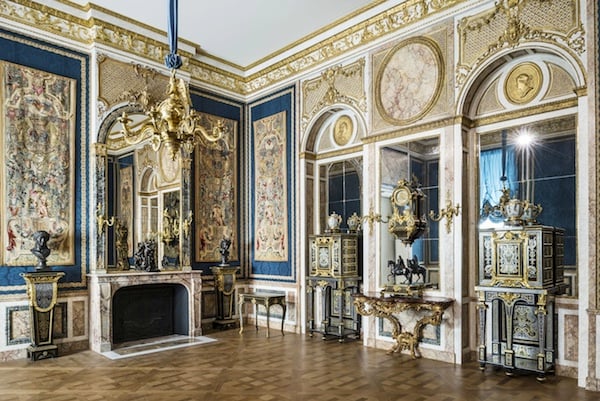
Paneling from the hôtel Le Bas de Montargis. View of the interior architecture. Paris, 1705, 1707 (niches, interior paneling and screens), modern additions. Artisians from the Society for the Buildings of the King (Jules Degoullons and associates). Sculpted wood, paint and gilding, glaze. Redistribution of French state cultural property, 1898. Paris, Louvre Museum © 2014 Louvre Museum, dist. RMN-GP/ Olivier Ouadah
On June 6, the Louvre will unveil one of its most ambitious capital projects to date: the redesign of its 18th century Decorative Arts galleries. Financed privately to the tune of $33 million ($4 million of which was raised by the American Friends of the Louvre), the new display spans a staggering 23,000 square feet. It promises to be an extravaganza of gold, precious woodcarvings, silverware, and tapestries, taking viewers through the history of royal patronage and the extravagant mores of the court, from the rise to power of the Sun King Louis XIV to the French Revolution.
Collection of faience plates and serving dishes from Rouen. Decorate with motifs of agrostemma githago (corncockles or wheat flowers) in ochre. Rouen (France), approximately 1700-1725. Paris, Louvre Museum © 2014 Louvre Museum, dist. RMN-GP/ Olivier Ouadah.
More than 2,200 pieces constitute the collection, which is to be displayed both in traditional galleries, and as part of the recreations of original interiors. A particular highlight of this new display—masterminded by interior designer Jacques Garcia in collaboration with the museum’s department of decorative arts—is the presentation of the whole Hôtel Dangé-Villemaré drawing room, which hasn’t been shown in its entirety since it was first acquired by the Louvre in the 19th century.
Interior architecture from the assembly room of l’hôtel Dangé. Paris, approximately 1750, with modern additions. Sculpted wood, paint and gilding, and glaze. Height to the cornice, 15’. Redistribution of French state cultural property 1898. Paris, Louvre Museum © 2014 Louvre Museum, dist. RMN-GP/ Olivier Ouadah
Located on the fashionable Place Vandôme, the Hôtel de Villmaré was built at the turn of the 18thcentury and bought in 1750 by François-Balthazar Dangé. The drawing room, with its intricate paneling and mirrors, has been fully restored as part of the project, and is considered one of the most refined surviving examples of interior from the period.
Paneling from the library from l’hôtel Dangé. Paris, approximately 1750, with modern additions. Sculpted wood, paint and gilding, glaze and white marble. Height to the cornice, 9’. Redistribution of French state cultural property, 1898. Paris, Louvre Museum © 2014 Louvre Museum, dist. RMN-GP/ Olivier Ouadah
Several other interiors have been recreated, including the library of l’Hôtel Dangé-Villemaré, the Grand Salon of the Château d’Abondant, and the ceremonial bedchamber at the Hôtel de Chevreuse. The furniture and objects have also been arranged in “decorative settings,” giving a sense of context to their presentation. A large proportion of the pieces come from royal residences: Versailles, the Tuileries, St Cloud, Fontainebleau, and Compiègne, as well as from palaces belonging to members of the aristocracy.
Paneling from the hôtel Le Bas de Montargis. Paris, 1705, 1707 (niches, interior paneling and screens), modern additions. Artisians from the Society for the Buildings of the King (Jules Degoullons and associates). Sculpted wood, paint and gilding, glaze. Redistribution of French state cultural property, 1898. Paris, Louvre Museum © 2014 Louvre Museum, dist. RMN-GP/ Olivier Ouadah
The 35 rooms highlight the instrumental role monarchs played in developing craftsmanship of the highest quality. Louis XIV famously created the Royal Tapestry Manufactory of the Gobelins, while Louis XV and his mistress Madame de Pompadour championed the Royal Porcelain Manufactory of Vincennes, which was later moved to Sèvres. Their production was consumed by the international elite far beyond the limits of the kingdom. The new galleries also put a particular emphasis on the artisans protected by the French kings, among them the legendary cabinet-maker André Charles Boulle.
Faience dishes and pottery depicting scenes from history, in the tradition of Castelli Maiolica earthenware, Pavie and Nevers (France) 1650-1700. Paris, Louvre Museum © 2014 Louvre Museum, dist. RMN-GP/ Olivier Ouadah.
“The Louvre’s new decorative arts galleries will embody the constant evolution of taste, flowing in a coherent movement from the ascension of a new style during Louis XIV’s reign to the time of Marie- Antoinette at the end of the Ancien Régime,” said Jacques Garcia in a statement. “The galleries will display a multitude of atmospheres, but will always remain true to the sense of the innovation and beauty that characterizes the Grand Siècle of decorative arts which, in France, was the 18th century.”